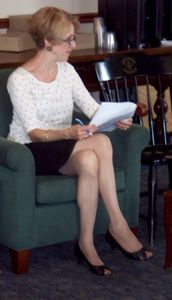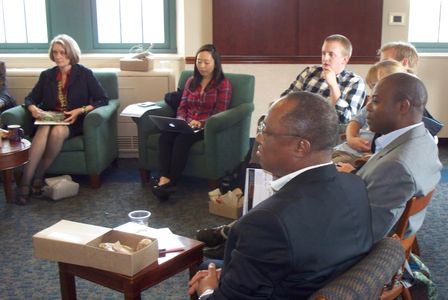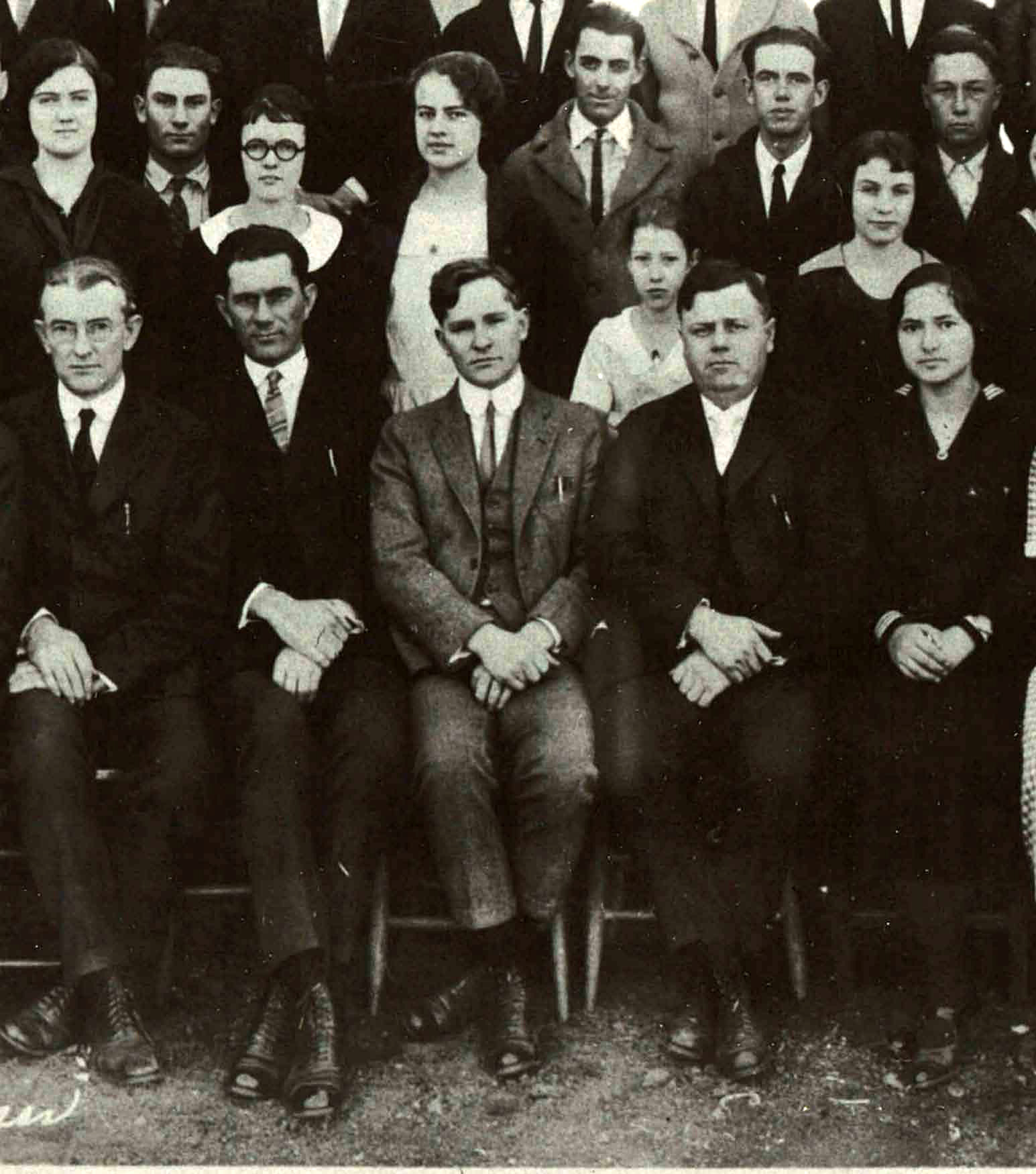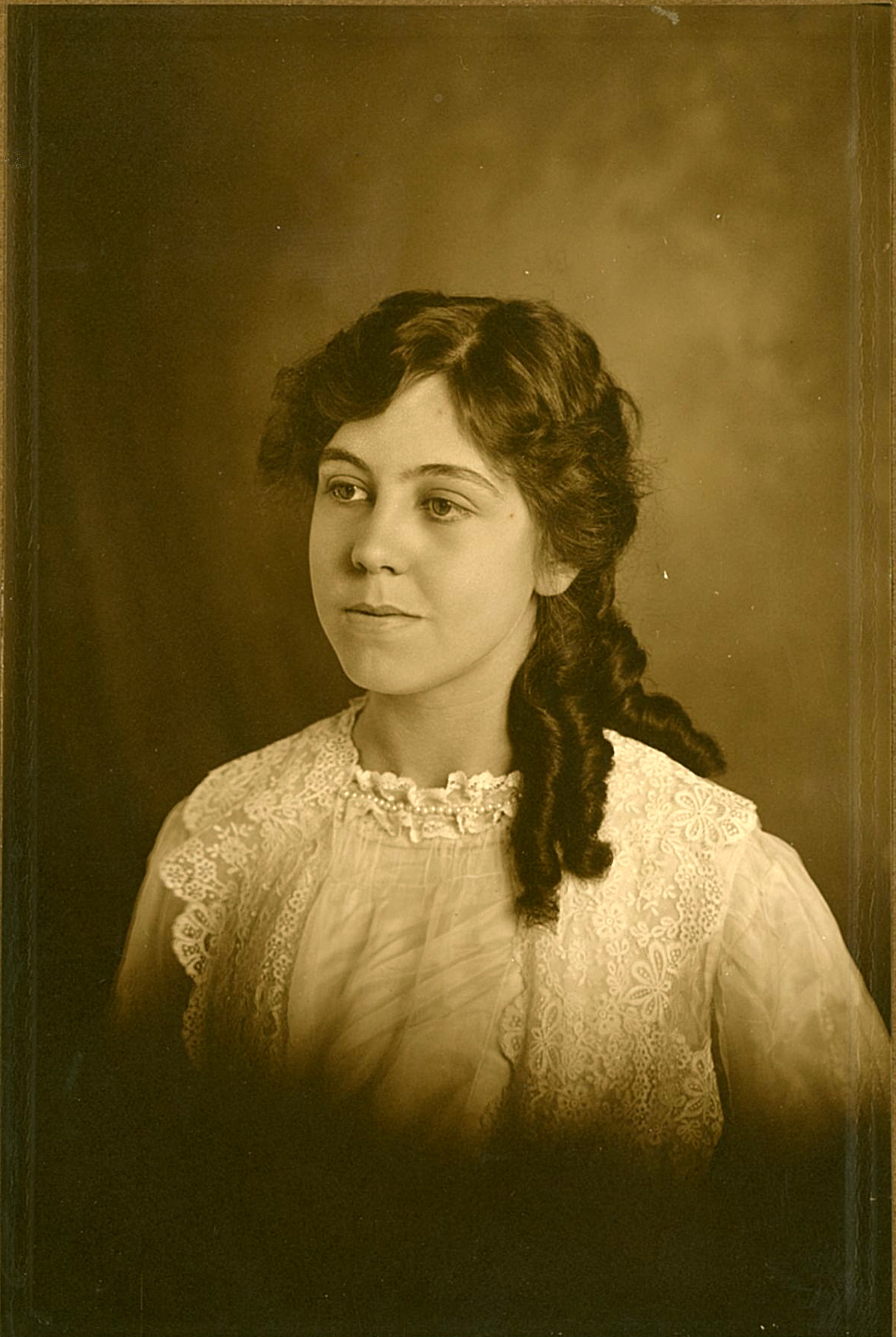Papers & Publications
Buddhist Monks, Christian Friars, and the Making of Buddhism
 In her recent article, “Buddhist Monks and Christian Friars: Religious and Cultural Exchange in the Making of Buddhism,” Eva Pascal (PhD Candidate) demonstrated that the idea of Buddhism as a common religion across much of Asia, did not emerge in the 19th century as has been widely assumed. Instead, it was Spanish Franciscan Friars in the 16th century who, in their interactions with Buddhist monks in Thailand, China, and Japan recognized a common core. The Franciscans not only perceived a single founder behind the various names used for the Buddha in Asia, they also recognized the features of "religion." In other words, Franciscans concluded that Buddhist monks were not merely superstitious--the label associated with heathen ideas. Instead, they began to use the term "religion" for Buddhist beliefs and practices, because the Franciscans recognized monks as their counterparts. Buddhist monks lived in monastic communities, adhered to a life of voluntary poverty, took vows of chastity, preached obedience to commandments, and the like. The parallels led the Franciscan missionaries to introduce Buddhism to the West as a religion, a total system comparable to Christianity.
In her recent article, “Buddhist Monks and Christian Friars: Religious and Cultural Exchange in the Making of Buddhism,” Eva Pascal (PhD Candidate) demonstrated that the idea of Buddhism as a common religion across much of Asia, did not emerge in the 19th century as has been widely assumed. Instead, it was Spanish Franciscan Friars in the 16th century who, in their interactions with Buddhist monks in Thailand, China, and Japan recognized a common core. The Franciscans not only perceived a single founder behind the various names used for the Buddha in Asia, they also recognized the features of "religion." In other words, Franciscans concluded that Buddhist monks were not merely superstitious--the label associated with heathen ideas. Instead, they began to use the term "religion" for Buddhist beliefs and practices, because the Franciscans recognized monks as their counterparts. Buddhist monks lived in monastic communities, adhered to a life of voluntary poverty, took vows of chastity, preached obedience to commandments, and the like. The parallels led the Franciscan missionaries to introduce Buddhism to the West as a religion, a total system comparable to Christianity.
Popular Spiritual Movements in Southeast Asia
The Handbook on Popular Spiritual Movements (PSM) in Malaysia, Singapore and Indonesia was a research project and publication owned by Trinity Theological College (TTC), Singapore, under the leadership of Dr. Michael Poon, Director of the Centre for the Study of Christianity in Asia (CSCA). Boston University, through the Center for Global Christianity and Mission, was a supportive partner through the participation of Dr. Charles Farhadian (PhD 2000) as a co-editor, Dr. Dana Robert as a consulting editor, and the Drs. Septemmy Lakawa (ThD, 2011), Daryl Ireland (PhD 2015), and David Scott (PhD, 2013) as contributors to section III: Case Studies of Popular Spiritual Movements.
Education as a Mission
Education as a Mission
The Greatest Work in the World: Education as a Mission of Early Twentieth
Century Churches of Christ. Letters of Lloyd Cline Sears and Pattie Hathaway Armstrong
The Stone-Campbell Connection
Influences of Stone-Campbell Movement leaders on the writers of these letters are several and strong, beginning with Pattie Hathaway’s grandfather, James A. Harding. In 1869, Harding graduated from Bethany, a rigorous, private college near the Allegheny Mountains founded by Alexander Campbell. Although Campbell had died before Harding enrolled, his educational philosophy still influenced that institution.[2] Harding particularly absorbed Campbell’s emphases on propagating widely-accessible, liberal arts-based training overseen by well-equipped teachers who could guide students in their “physical, intellectual and moral development.”[3] Scholars have observed that this model established the parameters for Churches of Christ educational institutions and Campbell’s influence in this regard is evident in The Greatest Work in the World.
Additionally apparent in the letters is the inspiration of Barton W. Stone, Campbell’s Kentucky-based colleague who may be best known for his leadership in the famous Cane Ridge Revival of 1801. The intellectual foundations on which Stone based his teachings about personal piety are less well remembered today. But traces of his skepticism about modern “progress;” his emphases on spiritual maturity accompanied by ethical actions; and his allegiance to powers beyond those of civil governments[4] are clearly discernable in this volume of correspondence.
This work originates from a family prominent in the Churches of Christ from the mid–1800s through the 1960s. Letters exchanged principally between my grandparents, Lloyd Cline Sears and Pattie Hathaway Armstrong, constitute the bulk of the work. Augmenting their posts are letters from family members J. N. and Ida Woodson (Harding) Armstrong and Pattie (Cobb) Harding, wife of James A. Harding. Written between 1915 and 1921 these letters express an educational philosophy and understanding of Christian purpose inspired by the Stone-Campbell Movement and held in tension with the intellectual and social ferment of the times.
As leaders in “the oldest ecumenical movement in America,”[1] the letter writers helped establish and run a series of small schools throughout the American South, Midwest, and West that influenced generations of students to become teachers, preachers, missionaries, and orphanage directors.
Today, Lipscomb University in Nashville, Tennessee is the oldest establishment in this legacy while Harding University in Searcy, Arkansas has been the institution most closely associated with the letter writers. Correspondence contained in The Greatest Work in the World dates from a time in between the founding of these two schools, when the authors were running Cordell Christian College in Oklahoma and Harper College in Kansas.
This primary source material allows rare access to privately expressed thoughts of men and women attempting to live as Christian educators at the outset of an uncertain and rapidly changing twentieth century. Their letters also offer encouraging lessons for contemporary American Christians in this even more volatile era.
Containing a foreword by Richard T. Hughes of Messiah College and an afterword by Larry R. Long of Harding University, The Greatest Work in the World is available from Wipf and Stock Publishers.
This webpage contains excerpts from the book along with extra material and photographs not found there.
[1] J. D. Murch, Christians Only, Eugene, OR: Wipf and Stock, 2004, 360.
[2] Lloyd Cline Sears, The Eyes of Jehovah, Nashville: Gospel Advocate, 1970, 10.
[3] Thomas H. Olbricht, “Alexander Campbell as an Educator,” Lectures in Honor of the Alexander Campbell Bicentennial, 1788-1988, Nashville: Disciples of Christ Historical Society, 1988, 85.
[4] Richard T. Hughes, Reviving the Ancient Faith: The Story of Churches of Christ in America, Grand Rapids: Eerdmans, 1996, 92
Elizabeth Cline Parsons, editor
Lecturer on Religion, Culture, and Development
Faculty Associate, CGCM
It is surprising to me how untaught the people of the country generally are. They have learned a few of the very first principles of Christianity and are blinded to all the rest. . . . And so bad is this condition that it will be impossible to change it in one or two generations. The people are not willing to receive the great lessons which they ought to have. . . . Preaching to these brethren might lift them up in two or three generations, but the trouble will be in getting a preacher. All the preachers they would have are the kind which would only emphasize the same condition, and make them worse instead of better. They need someone who can teach to live among them and work and make everyone else work. This can only be done by men trained from their boyhood. And I know of no better place to give boys this training than in a Bible school. We are engaged in the greatest work in the world, and it must go on. Even if you should die the work would have to continue, and I should do my best to carry it on. And I know if I should die you would keep it going; there would still be sufficient—more than sufficient—friends to make it go. And I hope to see it turn out hundreds of preachers, boys and girls, who will make a reformation throughout this whole country [Cline Sears, June 27, 1915]
I am of the opinion you are about our Bible School in the future. . . . In all the history of the school work the schools have been small. The Nashville Bible School is larger to day than it ever has been, but it is losing its spirituality—and we must not do that. The Orphan’s Home must not be large for the same reason. If the Home is crowded I can not have the influence over the children I must have to do what I believe the Lord would want me to do. It would be impossible for me to know each child’s disposition and to know what traits should be encouraged and what traits should be fought and mastered, and, too, I want them to know and love me, but they can not do it if I have too many. [Pattie Hathaway Armstrong, June 21, 1915]
There is a great difference between the people of the world and of the popular churches, and the people of the churches of Christ. Anything that is respectable and respected by society and the world is engaged in by the popular churches. War is not condemned, but is encouraged by the ministers. I heard a prayer recently for the “success of our arms in Mexico,”—which necessarily means the destruction of hundreds of lives and the ruin of hundreds of homes, yet because the world praises it as patriotism the preachers pray for it, and buy flags to lead the army in battle. [Cline Sears, July 17, 1916]
Just before church time I went to the post office just as I told you. The office was empty, so I stood by the window and read your letter in the twilight. I came up the street wishing I could be in a boat on the lake with you when I glanced up and almost caught my breath at the beauty of the scene. Under the trees and among the flowers in Mr. Lee’s yard were hundreds and hundreds of fireflies. I think I have never seen anything more beautiful. The whole world seemed filled with these tiny fairy lanterns. This time I didn’t cry at a beautiful scene. You enjoyed it quite as much as I did. There is quite an advantage in being together though separated, isn’t there? [Pattie Hathaway Armstrong, July 12, 1915]
Click Cordell Christian College Promotional Pamphlets to see some transcriptions of promotional pamphlets produced for Cordell Christian College. The pamphlets provide additional information and perspectives on the viewpoints of the letter writers.
Jesse Lee Prize Awarded to Doug Tzan
 The General Commission on Archive and History (GCAH) of The United Methodist Church announced the 2015 winner of its highly sought-after Jesse Lee Prize: The Rev. Dr. Douglas Tzan (pictured), elder and full member of the Baltimore-Washington Annual Conference. Tzan’s award winning manuscript is titled "The World His Circuit: The Methodist Odyssey of William Taylor."
The General Commission on Archive and History (GCAH) of The United Methodist Church announced the 2015 winner of its highly sought-after Jesse Lee Prize: The Rev. Dr. Douglas Tzan (pictured), elder and full member of the Baltimore-Washington Annual Conference. Tzan’s award winning manuscript is titled "The World His Circuit: The Methodist Odyssey of William Taylor."
This work is a case study of a Methodist preacher, missionary, author, evangelist and bishop who not only mobilized the then Methodist Episcopal Church across the American frontier but brought the same energy, organization and enthusiasm across six continents. William Taylor (1821-1902) introduced American revivalism in places other missionaries disregarded, growing churches among marginalized populations, especially in South Africa and India. Forged in American Methodism, his global encounters with different cultures, languages and religions shaped the ways and means of the entirety of Christian mission outreach for generations.
The Jesse Lee Prize, awarded once every four year is named for United Methodism’s first historian (1758-1816) and given for serious manuscripts about the denomination’s history, including studies of antecedent Methodist churches or its missions. The $2,000 prize is granted by GCAH to assist authors with publication of their manuscript related to Methodist history.
The Rev. Dr. Tzan currently serves on the staff of the Sykesville Parish (St. Paul’s and Gaither UMC) in Sykesville, Maryland. He holds a PhD. in the field of the History of Christianity from Boston University where his extensive research of William Taylor began. Tzan continued his research utilizing materials at the United Methodist Archives and History Center in Madison, New Jersey. Tzan is a graduate of Iliff School of Theology and The University of South Carolina. He teaches at Wesley Theological Seminary and Boston University School of Theology.
GCAH is pleased to sponsor the Jesse Lee Prize awarded next in 2019. Information about various awards, grants and prizes for scholarly work in Methodist History can be found at http://gcah.org/research/grants-and-awards .
Evangelicals Around the World
 In the newly released Evangelicals Around the World: A Global Handbook for the 21st Century, Gina Zurlo explains how evangelicals are counted. In an age when statistics are despised as "saying anything you want," Zurlo walks readers through the process of how the data is collected, analyzed, and interpreted so as to arrive at a reliable number of Evangelical Christians in the world. It is the only publication of its kind.
In the newly released Evangelicals Around the World: A Global Handbook for the 21st Century, Gina Zurlo explains how evangelicals are counted. In an age when statistics are despised as "saying anything you want," Zurlo walks readers through the process of how the data is collected, analyzed, and interpreted so as to arrive at a reliable number of Evangelical Christians in the world. It is the only publication of its kind.
Zurlo is a PhD candidate at Boston University, and is writing her dissertation on David Barrett and Christian demography.
Handbook of Popular Spiritual Movements in Malaysia, Singapore and Indonesia
This new volume, edited by Michael Nai-Chiu Poon and John Roxborogh, will provide broad insight into Christianity in major parts of South East Asia. Not only was CGCM director Dana Robert involved in the planning of the volume, but also a number of BU alumni made contributions, including consulting editor Charles Farhadian (’00), Daryl Ireland (’15), Septemmy Lakawa (’11), and David Scott (’13). 
World Christianity and the Holiness Movement
In September 2015, The Global Institute for the Fourfold Gospel Theology at Seoul Theological University launched the new peer-reviewed journal World Christianity and the Fourfold Gospel. Scholars from around the world contributed articles, launching a new periodical focused on the ways in which the international holiness movement helped to construct world Christianity.
The Advisory Board has three alumni of the Boston University School of Theology: Myung-soo Park ('92), Sung-Deuk Oak ('02), and Brian Clark ('08). In addition, the managing editor is Yeon-seung Lee ('11).
Articles from World Christianity and the Fourfold Gospel will be indexed in Religion Index One: Periodicals, the ATLA Religion Database, published by the American Theological Library Association.
The Indian Presence in the Ecumenical Movement
CGCM visiting researcher Jesudas Athyal's edited book A Light to the Nations: The Indian Presence in the Ecumenical Movement in the Twentieth Century is now available. 
There are a range of contributors in this volume, including Wesley Ariarajah (Former Director of WCC Interfaith department and Professor Emeritus of Ecumenical Theology at Drew University), Fr. K. M. George (Orthodox theologian), Preman Niles (Sri Lankan theologian) and Jayakiran Sebastian (Dean, Lutheran Theological Seminary at Philadelphia).
World Council of Churches Publications makes this important book available, and it can be purchased at the American Academy of Religion conference in Atlanta, GA this year (WCC Publications booth 613), or through amazon: http://www.amazon.com/Light-
Education as a Mission

 On September 25, Professor Liz Parsons gave a lecture about her new book The Greatest Work in the World: Education as a Mission of Early Twentieth Century Churches of Christ. She spoke about her research on the exchanges written between Lloyd Cline Sears (1895-1986) and Pattie Hathaway Armstrong (1899-1977), two prominent leaders of Churches of Christ. She talked about the major themes she found in these letters, mainly focusing on their educational philosophy and their counter-cultural perspective. Jeremy Hegi, a third year Ph.D student, responded. There was a lively discussion concerning the practical implication of the letters for contemporary American Christians. Many CGCM faculty members and students joined the discussion.
On September 25, Professor Liz Parsons gave a lecture about her new book The Greatest Work in the World: Education as a Mission of Early Twentieth Century Churches of Christ. She spoke about her research on the exchanges written between Lloyd Cline Sears (1895-1986) and Pattie Hathaway Armstrong (1899-1977), two prominent leaders of Churches of Christ. She talked about the major themes she found in these letters, mainly focusing on their educational philosophy and their counter-cultural perspective. Jeremy Hegi, a third year Ph.D student, responded. There was a lively discussion concerning the practical implication of the letters for contemporary American Christians. Many CGCM faculty members and students joined the discussion.
School of Theology and the General Board of Higher Education and Ministry Collaborate to Launch Digital Archive of motive Magazine
“The magazine, motive, challenged me beyond natural ability.”
Jeanne Audrey Powers
On September 16, Boston University School of Theology and the General Board of Higher Education and Ministry will celebrate the launch of a website that digitizes motive magazine and makes it accessible to a new generation of scholars and leaders. motive magazine shaped a generation of young, passionate activists and leaders. The event will feature an art display beginning at 4:30 pm and a celebratory event at 5:00 pm, with a Readers' Theater, presentation of the new website, and panelists.
motive was the official magazine for the Methodist Student Movement from its founding in 1941 and, for a few years at the end of its life, for the entire University Christian Movement (UCM). Much celebrated even at the time for its avant-garde editorial and artistic vision, in 1966 Time magazine said it stood out among church publications “like a miniskirt at a church social.” It was the single runner-up to Life as Magazine of the Year in 1965. Its strong stance on civil rights, Vietnam, and emerging gender issues were provocative at the time and the magazine ceased publication in 1972.
The Center for Global Christianity and Mission in collaboration with the School of Theology Library has made all of the issues available online and searchable. This event will mark the launch of the new resource on the Church, the student movement, and critical issues from the middle of the 20th century.
Panelists include:
B.J. Stiles, former editor of motive magazine;
Frank Lloyd Dent, author of the dissertation motive magazine: Advocating the Arts and Empowering the Imagination in the Life of the Church; and
Tom Driver, contributor to motive magazine and retired professor at Union Theological Seminary.
by Betty Elrod
- See more at: http://www.gbhem.org/article/boston-university-school-theology-and-general-board-higher-education-and-ministry-celebrate#sthash.1aMfSgM0.dpuf








